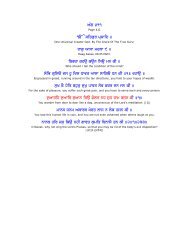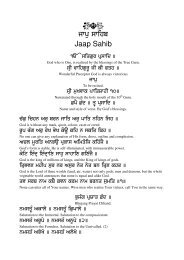Jeavini of Bhai Vir Singh Ji - Panth Rattan
Jeavini of Bhai Vir Singh Ji - Panth Rattan
Jeavini of Bhai Vir Singh Ji - Panth Rattan
- No tags were found...
You also want an ePaper? Increase the reach of your titles
YUMPU automatically turns print PDFs into web optimized ePapers that Google loves.
Khalsa Diwan, Sikh EducationalSociety (1908) and the Punjab andSind Bank (1908). Interest incorporate activity directed towardscommunity development remained<strong>Bhai</strong> <strong>Vir</strong> <strong>Singh</strong>'s constant concern,simultaneously with his creativeand scholarly pursuits. In thisengagement and, at the same time,in his eschewal <strong>of</strong> political activity,the Christian missionary examplewas apparently his model.In determining the basicparameters <strong>of</strong> the modern phase <strong>of</strong>Sikhism, <strong>Bhai</strong> <strong>Vir</strong> <strong>Singh</strong> stressedthe autonomy <strong>of</strong> Sikh faithnourished and sustained by anawakening amongst the Sikhs <strong>of</strong>the awareness <strong>of</strong> their distincttheological and cultural identity.Secondly, he aimed at reorientingthe Sikhs' understanding <strong>of</strong> theirfaith in such a manner as to helpthem assimilate the differentmodernizing influences to theirhistorical memory and culturalheritage. Education <strong>of</strong> the masseswas the first requirement for thefulfilment <strong>of</strong> these objectives. In themeanwhile, the old educationalsystem which had till then servedas a channel for communication <strong>of</strong>the traditional knowledge to theyouth <strong>of</strong> the race had broken downwith the withdrawal, under Britishdispensation, <strong>of</strong> state patronagefrom the indigenous institutions, Asif to fill the vacuum as well as tobuild new channels <strong>of</strong> intracommunitycommunication, <strong>Bhai</strong><strong>Vir</strong> <strong>Singh</strong> through his singlemindedcultivation <strong>of</strong> Punjabilanguage as the medium <strong>of</strong> histheological, scholarly and creativework, resolved the cultural dilemmawhich the Sikhs faced at the turn <strong>of</strong>the century. On the one hand wasthe Sikh literary tradition in Brajlanguage which had collectedunmatched riches in multipledirections during the course <strong>of</strong> itsthree-centuries-long elitist career,on the other were the compulsionsfor mobilizing the common Sikhsthrough their own language. Bydrawing upon the Sikh tradition <strong>of</strong>Braj literature for his basicinspiration and cultural motivationand upon the Punjabi literarytradition for its linguisticcomponents <strong>Bhai</strong> <strong>Vir</strong> <strong>Singh</strong>initiated a new literary idiomdistinctly different from both. Thetracts produced by the KhalsaTract Society introduced a down toearth literary Punjabi remarkablefor lightness <strong>of</strong> touch as well as forfreshness <strong>of</strong> expression. In thiswriting lay the beginnings <strong>of</strong>modern Punjabi prose.The Khalsa Tract Societyperiodically made available underthe title Nirguniara lowcostpublications on Sikh theology,history and philosophy and onsocial and religious reforrn.Through this journal <strong>Bhai</strong> <strong>Vir</strong> <strong>Singh</strong>established a living contact with aneverexpanding circle <strong>of</strong> readers.He used the Nirguniara as avehicle for his own self expressionand some <strong>of</strong> his major creativeworks such as the epic Rana Surat
<strong>Singh</strong>, the novel Baba Naudh<strong>Singh</strong>, and the lives <strong>of</strong> the GurusSri Guru Nanak Chamatkar and SriGuru Kalgidhar Chamatkar wereoriginally serialized in its columns.In literature, <strong>Bhai</strong> <strong>Vir</strong> <strong>Singh</strong> startedas a writer <strong>of</strong> romances whichproved to be the forerunners <strong>of</strong> thePunjabi novel. His writings in thisgenre- Sundari (1898), Bijay <strong>Singh</strong>(1899), Satvant Kaur (published intwo parts, I in 1900 and II in 1927)-were aimed at recreating the heroicperiod (eighteenth century) <strong>of</strong> Sikhhistory. Through these novels hemade available to his readerstypical models <strong>of</strong> courage, fortitudeand human dignity.Subhagji da Sudhar Hathin BabaNaudh <strong>Singh</strong>, popularly known asBaba Naudh <strong>Singh</strong> (serialized inNirguniara from 1907 onwards andpublished in book form in 1921)shares with Rana Surat <strong>Singh</strong> (which he had started serializingtwo years earlier), <strong>Bhai</strong> <strong>Vir</strong> <strong>Singh</strong>'sfascination with the theme <strong>of</strong>widow's desperate urge for a reunionwith her dead husband. Butin Baba Naudh <strong>Singh</strong> this search issituated in a more mundanesetting. This makes all thedifference. The narrative here ismore realistic in tone, and almostcontemporary in its appeal. <strong>Bhai</strong><strong>Vir</strong> <strong>Singh</strong> weaves into the narrativenumerous motifs <strong>of</strong> social reformsmoral teaching and religiouspreaching and depicts severalsituations <strong>of</strong> intercommunal andurban-rural confrontation. In 1905,<strong>Bhai</strong> <strong>Vir</strong> <strong>Singh</strong> started serializingthrough tracts Rana Surat <strong>Singh</strong>,the first Punjabi epic, written inblank verse <strong>of</strong> Sirkhand, variety.This long narrative <strong>of</strong> over 14,000lines is a striking imaginativeevocation <strong>of</strong> the situation <strong>of</strong> theSikhs through a symbolic tale <strong>of</strong> awidowed queen in quest <strong>of</strong> her lostparadise. The spiritual voyage <strong>of</strong>Rani Raj Kaur, the mainprotagonist <strong>of</strong> the poem, fromexternal factuality to internalessence has been described by<strong>Bhai</strong> <strong>Vir</strong> <strong>Singh</strong> in the form <strong>of</strong> afantasy <strong>of</strong> spiritual ascension.Apart from living out her earthlydestiny <strong>of</strong> suffering and pain, shesymbolized the total ethos <strong>of</strong> theSikh people at that historicalmoment when they were emergingout <strong>of</strong> their sense <strong>of</strong> defeat anddespair into an era <strong>of</strong> a freshbeginning.<strong>Bhai</strong> <strong>Vir</strong> <strong>Singh</strong>'s quest for newforms <strong>of</strong> expression continued.Soon after the pubtication <strong>of</strong> RanaSurat <strong>Singh</strong> in book form in 1919,he turned to shorter poems andLyrics. In quick succession cameDil Tarang (1920), Earel Tupke (1921), Lahiran de Har (1921),Matak Hulare (1922), and Bijlian deHar (1927). Following at somedistance was Mere Salan <strong>Ji</strong>o(1953). In this poetry, <strong>Bhai</strong> <strong>Vir</strong><strong>Singh</strong>'s concerns were moreaesthetic than didactic,metaphysical or mystical. Herefined the old verse forms andcreated new ones. The metrical
patterns Kabir, Soratha, Baint, etc.,which he inherited from classicalPunjabi literature, weretransformed into lights nimblemeasures. <strong>Bhai</strong> <strong>Vir</strong> <strong>Singh</strong> alsonaturalized in Punjabi the Rubaiwhich he borrowed from Urdu. Bygrafting Soratha and Sirkhandvforms on English blank verse, hepaved the way for the emergence<strong>of</strong> Punjabi poem. As it happened,the first play written in Punjabi,Raja Lakhdata <strong>Singh</strong> (1910)* alsocame from the pen <strong>of</strong> <strong>Bhai</strong> <strong>Vir</strong><strong>Singh</strong>. Tentative in form, the 1. playdid reveal the author's powers <strong>of</strong>constructing crisp and wittydialoguesb Change-over from BrajBhasa to Punjabi 2. as the mainmedium <strong>of</strong> Sikh literary and 3.scholarly expression created theneed for new materials such asglossaries,lexicons,encyclopaedias and exegeticalworks. <strong>Bhai</strong> <strong>Vir</strong> <strong>Singh</strong> himselfprovided several <strong>of</strong> the tools. Herevised and enlarged Giani Hazara<strong>Singh</strong>'s dictionary, Sri Guru GranthKosh, originally published in 1898.The revised version, published in1927, gave evidence <strong>of</strong> <strong>Bhai</strong> <strong>Vir</strong><strong>Singh</strong>'s command <strong>of</strong> the science <strong>of</strong>etymology and <strong>of</strong> the classical andmodern languages. He publishedcritical editions <strong>of</strong> some <strong>of</strong> the oldSikh texts such as Sikhan diBhagat Mala (1912), Prachin <strong>Panth</strong>Prakash (1914), Puratan JanamSakhi (1926) and Sakhi Pothi(1950).Monumental in size andscholarship was his annotation <strong>of</strong><strong>Bhai</strong> Santokh <strong>Singh</strong>'s magnumopus, Sn Gur Pratap Suraj Granth,published from 1927 to 1935 infourteen volumes covering 6668pages.No sooner was the Sri Gur PratapSuraj Grallth completed than <strong>Bhai</strong><strong>Vir</strong> <strong>Singh</strong> launched on an evenmore arduous task. This was adetailed commentary on the GuruGranth Sahib. In a way, exegesishad been his lifelong occupation.Early in his career he hadannotated selections from the HolyBook published in 1906 under thetitle Panj Granth Saiik, and, as hehimself declared, all <strong>of</strong> his writingwas an exposition <strong>of</strong> the SikhScripture. He devoted himselfunsparingly to the commentary, butit remained unfinished. A lifetime <strong>of</strong>unrelieved hard work and theweight <strong>of</strong> advancing years at lastbegan to tell. In early 1957 signs <strong>of</strong>fatigue and weakness appeared.He was taken ill with a fever anddied in his home in Amritsar on 10June 1957. The portion <strong>of</strong> thecommentary- nearly one half <strong>of</strong> theHoly Book- he had completed waspublished posthumously in sevenlarge volumes.Article taken from:Encyclopedia <strong>of</strong> Sikhism editedby Harbans <strong>Singh</strong> ji.<strong>Bhai</strong> <strong>Vir</strong> <strong>Singh</strong>: Life, Times andWorks. by Gurbachan <strong>Singh</strong>Talib, and Attar <strong>Singh</strong>, ed.,Chandigarh,1973 <strong>Bhai</strong> <strong>Vir</strong> <strong>Singh</strong>Harbans <strong>Singh</strong>, Delhi, 1972<strong>Bhai</strong> <strong>Vir</strong> <strong>Singh</strong>: Poet <strong>of</strong> theSikhs. Harbans <strong>Singh</strong> andGurbachan <strong>Singh</strong> Talib
















